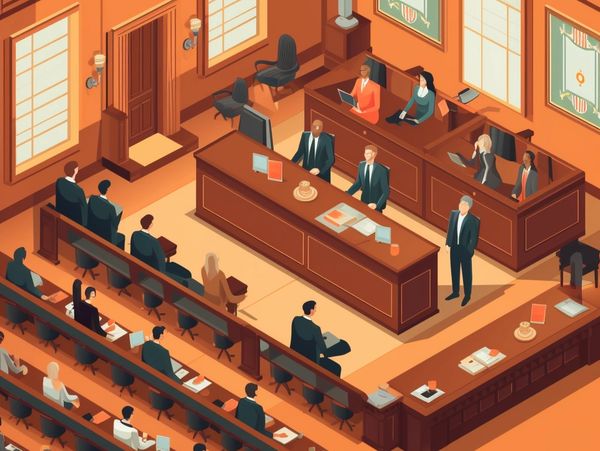Browsing the Intricacies of Trial Presentations: Tips for Seamless Shipment and Compelling Debates
In the realm of lawful procedures, the art of test presentation stands as a crucial component of success. As attorneys browse the elaborate internet of court characteristics, the ability to flawlessly provide debates and evidence while astounding the jury's interest becomes vital. The complexities intrinsic in test presentations need a fragile balance of ability, strategy, and finesse. By honing techniques that make sure a sleek delivery and crafting compelling disagreements that reverberate with the audience, lawyers can dramatically enhance their advocacy. In a world where persuasion reigns supreme, grasping the ins and outs of trial presentations is not simply an alternative yet a necessity for those seeking to prevail in the court.

Understanding Trial Goals
To properly browse a trial, it is essential to have a clear understanding of the goals that require to be attained. Prior to stepping into the courtroom, legal teams need to specify their objectives and wanted outcomes. These objectives act as directing principles throughout the trial, shaping methods and affecting decision-making procedures.
Recognizing trial purposes involves a comprehensive analysis of the instance, lawful criteria, and the customer's benefits. Trial Presentations. It calls for a thorough examination of the facts, recognizing vital concerns, and preparing for possible obstacles. By establishing certain and measurable goals, lawyers can customize their debates and presentations to line up with the desired results
In addition, a clear grip of test goals enables lawful groups to prioritize evidence, witnesses, and lawful disagreements successfully. It enables the development of a meaningful narrative that resonates with the discretionary, reinforcing the total instance discussion.

Organizing Evidence Properly
Having a clear understanding of test goals lays the structure for organizing proof successfully in legal process - Trial Presentations. By lining up the presentation of evidence with the preferred outcomes of the test, legal groups can enhance their disagreements and enhance their persuasiveness. One crucial facet of arranging evidence is categorization. Organizing evidence based upon styles or significance to specific lawful aspects can help simplify the discussion and make complex details a lot more digestible for the court or jury.
An additional secret element in arranging evidence successfully is establishing a sensible flow. Providing evidence in a sequential and systematic manner can aid build an engaging story that supports the lawful arguments being made. Furthermore, making use of visual help such as charts, charts, or timelines can additionally enhance the organization of proof and aid in clarifying complicated relationships or sequences of occasions.
In addition, guaranteeing that all proof offered is appropriate and permissible to the case is necessary. Inadmissible or unimportant evidence can interfere with the toughness of the debate and potentially harm the integrity of the here and now party. A careful evaluation and choice click for more info procedure must be embarked on to consist of just the most lawfully sound and impactful evidence in the trial presentation.
Crafting Persuasive Narratives
Crafting compelling narratives plays an essential duty in offering influential arguments during legal proceedings. A well-crafted narrative has the power to captivate the audience, evoke emotions, and eventually persuade the decision for the here and now party. When creating a narrative for a test presentation, it is crucial to develop a clear storyline that highlights bottom lines and links them in a meaningful way. Begin by detailing the truths of the situation in a compelling manner, guaranteeing that the sequence of events is very easy to Visit Website adhere to. Present personalities properly, supplying history info that helps the audience recognize their actions and motivations. In addition, including brilliant descriptions and engaging language can bring the story to life, making it extra unforgettable for the judge and jury. By weaving with each other proof, testimony, and legal debates into a convincing and cohesive story, lawyers can effectively support for their clients and increase the chance of a positive result in the courtroom.
Understanding Aesthetic Aids
Efficient usage of visual aids is vital to enhancing the effect and quality of trial presentations. Aesthetic aids, when used purposefully, have the power to simplify complicated info, enhance essential points, and leave a long-term impression on the discretionary. To understand aesthetic help in trial presentations, it is vital to ensure that they are clear, concise, and appropriate to the disagreements being made.
When including aesthetic help, such as charts, photographs, timelines, or graphs, into a trial presentation, it is vital to maintain them aesthetically appealing yet expert. The visuals need to enhance the spoken debates, giving a graph of the details being reviewed without frustrating the target market with unneeded information.
In addition, exercising with the aesthetic help in advance is necessary to make certain a smooth distribution throughout the trial. Familiarizing oneself with the content, transitions, and timings of each aesthetic help can assist maintain the flow of the discussion and protect against technological glitches that may arise.
Delivering Impactful Closing Debates
A compelling closing debate serves as the end result of a trial discussion, encapsulating the core story and persuading the court and jury in the direction of a favorable choice. Begin by outlining the primary arguments that support your customer's explanation position, stressing why the evidence offered throughout the trial sustains your story.
Additionally, incorporating sob story can better reinforce your closing debate. By linking and humanizing the case on a personal degree with the decision-makers, you can evoke compassion and understanding, affecting their perception of the truths presented. Additionally, reiterating the lawful requirements that need to be met for a desirable ruling can strengthen the legitimacy of your position. Ultimately, a well-crafted closing disagreement need to leave a lasting impression, compelling the court and court to regulation in your client's favor.
Conclusion
Finally, mastering trial presentations involves comprehending goals, organizing evidence, crafting narratives, utilizing visual aids, and delivering impactful closing arguments. By implementing these techniques successfully, attorneys can provide their situation perfectly and make compelling arguments in the courtroom. It is crucial to navigate the intricacies of test presentations with precision and skill to attain success in lawful procedures.
By lining up the presentation of proof with the wanted results of the trial, legal groups can strengthen their disagreements and enhance their persuasiveness (Trial Presentations). To master aesthetic aids in trial discussions, it is critical to make sure that they are clear, concise, and relevant to the debates being made
An engaging closing argument offers as the conclusion of a trial discussion, enveloping the core narrative and encouraging the judge and jury in the direction of a beneficial decision. Begin by laying out the primary arguments that sustain your client's placement, highlighting why the evidence offered throughout the trial sustains your narrative.In verdict, grasping trial discussions involves recognizing objectives, arranging evidence, crafting stories, utilizing aesthetic aids, and supplying impactful closing disagreements.